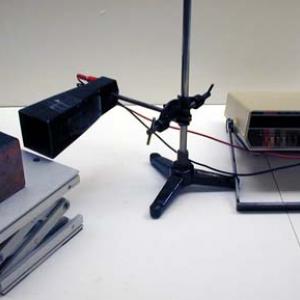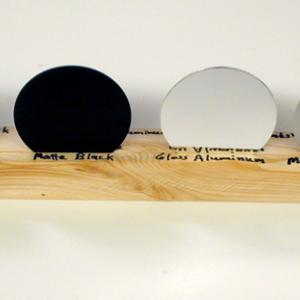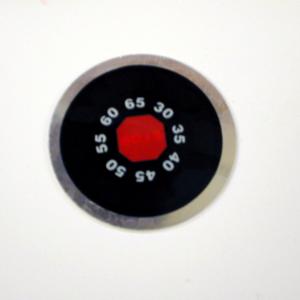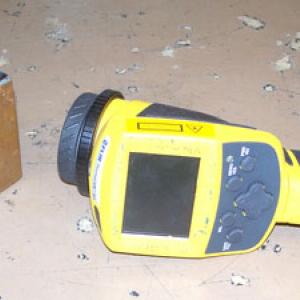College of Liberal Arts & Sciences
4B40.30 - Leslie's Cube
Fill the cube with hot water before demonstrating. The painted and unpainted side will give different reading thus showing a black body radiation effect. Be sure to empty the cube afterwards to avoid mineral buildup. Set the multimeter to the most sensitive DC voltage scale ( 200 micro volts range ).
The four aluminum disks each have a different front surface finish. They are, gloss black, matte black, gloss aluminum, and matte aluminum. Each of the disks has a liquid crystal thermometer attached to the back side. Set the disks at equal distances from a heat source and monitor the temperature vs. time.
- Ronald Bryan, "Why Shiny Metals Are Poor Emitters of Radiation", TPT, Vol. 45, # 4, April 2007, p. 222.
- "Figuring Physics", TPT, Vol. 43, # 1, Jan. 2005, p. 47.
- "Figuring Physics", TPT, Vol. 42, # 2, Feb. 2004, p. 118.
- George Barnes, "Jackrabbit Ears and Other Physics Problems", TPT, Vol. 28, # 3, p. 156, March 1990.
- Richard A. Bartels, "Do Darker Objects Really Cool Faster?", AJP, 244, Vol. 58, No. 3, March 1990.
- Hf-1: Freier and Anderson, A Demonstration Handbook for Physics.
- Jearl Walker, "4.59, Black Robes and Black Sheep in the Desert", The Flying Circus of Physics Ed. 2, p. 202.
- 4.5.5: John H. Moore, Christopher C. Davis, Michael A. Coplan, "Continuum Sources", Building Scientific Apparatus Second Edition, p. 196-199.
- Gerard L' E Turner, "Radiant Energy", Nineteenth-Century Scientific Instruments, p. 119-120.
- Yaakov Kraftmakher, "1.18, Kirhhoff's Rule", Experiments and Demonstrations in Physics, ISBN 981-256-602-3, p. 68.
- Tik L. Liem, "Which Coin Will Stay On Longer", Invitations to Science Inquiry - Supplement to 1st and 2nd Ed. p. 82.
- The Queen Catalogues Vol. II, Catalogue of Physical Instruments, No. 4975, p. 60.
Disclaimer: These demonstrations are provided only for illustrative use by persons affiliated with The University of Iowa and only under the direction of a trained instructor or physicist. The University of Iowa is not responsible for demonstrations performed by those using their own equipment or who choose to use this reference material for their own purpose. The demonstrations included here are within the public domain and can be found in materials contained in libraries, bookstores, and through electronic sources. Performing all or any portion of any of these demonstrations, with or without revisions not depicted here entails inherent risks. These risks include, without limitation, bodily injury (and possibly death), including risks to health that may be temporary or permanent and that may exacerbate a pre-existing medical condition; and property loss or damage. Anyone performing any part of these demonstrations, even with revisions, knowingly and voluntarily assumes all risks associated with them.




